Method for the Determination of Solvent Sorption of Polylactic Acid and the Effect of Essential Oils on the Sorption Properties
Abstract
1. Introduction
2. Materials and Methods
2.1. Materials
2.2. Methods
3. Results
3.1. Granules Solvent Sorption
3.1.1. Solvent Sorption in Ethanol Solutions
3.1.2. Solvent Sorption in Methanol Solutions
3.1.3. Solvent Sorption in Hexane Solutions
3.2. Granules Essential Oil
3.2.1. Essential Oil Adsorption in Ethanol Solutions
3.2.2. Essential Oil Adsorption in Methanol Solutions
3.2.3. Essential Oil Adsorption in Hexane Solutions
3.3. Correlation with the Hansen Solubility Parameter
3.4. Thermal Characteristic of the PLA Granules
4. Conclusions
Author Contributions
Funding
Data Availability Statement
Conflicts of Interest
References
- Bhavaniramya, S.; Vishnupriya, S.; Al-Aboody, M.S.; Vijayakumar, R.; Baskaran, D. Role of essential oils in food safety: Antimicrobial and antioxidant applications. Grain Oil Sci. Technol. 2019, 2, 49–55. [Google Scholar] [CrossRef]
- Martins, I.M.; Barreiro, M.F.; Coelho, M.; Rodrigues, A.E. Microencapsulation of essential oils with biodegradable polymeric carriers for cosmetic applications. Chem. Eng. J. 2014, 245, 191–200. [Google Scholar] [CrossRef]
- Sharma, S.; Barkauskaite, S.; Jaiswal, A.K.; Jaiswal, S. Essential oils as additives in active food packaging. Food Chem. 2021, 343, 128403. [Google Scholar] [CrossRef] [PubMed]
- Farah, S.; Anderson, D.G.; Langer, R. Physical and mechanical properties of PLA, and their functions in widespread applications—A comprehensive review. Adv. Drug Deliv. Rev. 2016, 107, 367–392. [Google Scholar] [CrossRef]
- Rasal, R.M.; Janorkar, A.V.; Hirt, D.E. Poly(lactic acid) modifications. Prog. Polym. Sci. 2010, 35, 338–356. [Google Scholar] [CrossRef]
- Saini, P.; Arora, M.; Ravi Kumar, M.N.V. Poly(lactic acid) blends in biomedical applications. Adv. Drug Deliv. Rev. 2016, 107, 47–59. [Google Scholar] [CrossRef] [PubMed]
- Udayakumar, G.P.; Muthusamy, S.; Selvaganesh, B.; Sivarajasekar, N.; Rambabu, K.; Banat, F.; Sivamani, S.; Sivakumar, N.; Hosseini-Bandegharaei, A.; Show, P.L. Biopolymers and composites: Properties, characterization and their applications in food, medical and pharmaceutical industries. J. Environ. Chem. Eng. 2021, 9, 105322. [Google Scholar] [CrossRef]
- Liu, D.; Li, H.; Jiang, L.; Chuan, Y.; Yuan, M.; Chen, H. Characterization of Active Packaging Films Made from Poly(Lactic Acid)/Poly(Trimethylene Carbonate) Incorporated with Oregano Essential Oil. Molecules 2016, 21, 695. [Google Scholar] [CrossRef]
- Zhang, W.; Jiang, H.; Rhim, J.W.; Cao, J.; Jiang, W. Effective strategies of sustained release and retention enhancement of essential oils in active food packaging films/coatings. Food Chem. 2022, 367, 130671. [Google Scholar] [CrossRef]
- Ahmed, J.; Mulla, M.Z.; Arfat, Y.A. Thermo-mechanical, structural characterization and antibacterial performance of solvent casted polylactide/cinnamon oil composite films. Food Control 2016, 69, 196–204. [Google Scholar] [CrossRef]
- Qin, Y.; Li, W.; Liu, D.; Yuan, M.; Li, L. Development of active packaging film made from poly (lactic acid) incorporated essential oil. Prog. Org. Coat. 2017, 103, 76–82. [Google Scholar] [CrossRef]
- Auras, R.; Harte, B.; Selke, S. Sorption of ethyl acetate and d-limonene in poly(lactide) polymers. J. Sci. Food Agric. 2006, 86, 648–656. [Google Scholar] [CrossRef]
- Vayer, M.; Vital, A.; Sinturel, C. New insights into polymer-solvent affinity in thin films. Eur. Polym. J. 2017, 93, 132–139. [Google Scholar] [CrossRef]
- Hansen, C.M. Hansen Solubility Parameters: A User’s Handbook, 2nd ed.; CRC Press: Boca Raton, FL, USA, 2007. [Google Scholar]
- Martins, I.M.; Rodrigues, S.N.; Barreiro, M.F.; Rodrigues, A.E. Release Studies of Thymol and p Cymene from Polylactide Microcapsules. Ind. Eng. Chem. Res. 2012, 51, 11565–11571. [Google Scholar] [CrossRef]
- Martins, I.M.; Rodrigues, S.N.; Barreiro, M.F.; Rodrigues, A.E. Microencapsulation of thyme oil by coacervation. J. Microencapsul. 2009, 26, 667–675. [Google Scholar] [CrossRef]
- Martins, I.M.; Rodrigues, S.N.; Barreiro, M.F.; Rodrigues, A.E. Polylactide-Based Thyme Oil Microcapsules Production: Evaluation of Surfactants. Ind. Eng. Chem. Res. 2011, 50, 898–904. [Google Scholar] [CrossRef]
- Xiao, Z.; Wan, S.; Niu, Y.; Kou, X. Effect of Preparation Parameters on Microparticles with High Loading Capacity and Adsorption Property Adsorbed on Functional Paper. Coatings 2019, 9, 704. [Google Scholar] [CrossRef]
- Villegas, C.; Torres, A.; Rios, M.; Rojas, A.; Romero, J.; de Dicastillo, C.L.; Valenzuela, X.; Galotto, M.J.; Guarda, A. Supercritical impregnation of cinnamaldehyde into polylactic acid as a route to develop antibacterial food packaging materials. Food Res. Int. 2017, 99, 650–659. [Google Scholar] [CrossRef] [PubMed]
- Helal, M.A.; Abdel-Gawad, A.M.; Kandil, O.M.; Khalifa, M.M.E.; Morrison, A.A.; Bartley, D.J.; Cave, G.W.V.; Elsheikha, H.M. Microfluidic-Based Formulation of Essential Oils-Loaded Chitosan Coated PLGA Particles Enhances Their Bioavailability and Nematocidal Activity. Pharmaceutics 2022, 14, 2030. [Google Scholar] [CrossRef]
- Martins, I.M.; Rodrigues, S.N.; Barreiro, M.F.; Rodrigues, A.E. Release of Thyme Oil from Polylactide Microcapsules. Ind. Eng. Chem. Res. 2011, 50, 13752–13761. [Google Scholar] [CrossRef]
- Biswal, A.K.; Vashisht, I.; Khan, A.; Sharma, S.; Saha, S. Synthesis, characterization and antibacterial activity of thymol-loaded polylactic acid microparticles entrapped with essential oils of varying viscosity. J. Mater. Sci. 2019, 54, 9745–9758. [Google Scholar] [CrossRef]
- Dusankova, M.; Pummerova, M.; Sedlarik, V. Microspheres of essential oil in polylactic acid and poly(methyl methacrylate) matrices and ther blends. J. Microencapsul. 2019, 36, 305–316. [Google Scholar] [CrossRef] [PubMed]
- Sato, S.; Gondo, D.; Wada, T.; Kanehashi, S.; Nagai, K. Effects of Various Liquid Organic Solvents on Solvent-Induced Crystallization of Amorphous Poly(lactic acid) Film. J. Appl. Polym. Sci. 2013, 129, 1607–1617. [Google Scholar] [CrossRef]
- Van Krevelen, D.W.; Nijenhuis, K.T. Properties of Polymers: Their Correlation with Chemical Structure; Their Numerical Estimation and Prediction from Additive Group Contributions; Elsevier: Amsterdam, The Netherlands, 2009; pp. 201–225. [Google Scholar]
- NatureWorks, Ingeo Biopolymer 3D850 Technical Data Sheet. Available online: https://www.natureworksllc.com/~/media/Files/NatureWorks/Technical-Documents/Technical-Data-Sheets/TechnicalDataSheet_3D850_monofilament_pdf.pdf (accessed on 1 August 2022).
- NatureWorks, Ingeo Biopolymer 4043D Technical Data Sheet. Available online: https://www.natureworksllc.com/~/media/Technical_Resources/Technical_Data_Sheets/TechnicalDataSheet_4043D_films_pdf.pdf (accessed on 1 August 2022).
- Carrasco, F.; Pagès, P.; Gámez-Pérez, J.; Santana, O.; Maspoch, M. Processing of poly(lactic acid): Characterization of chemical structure, thermal stability and mechanical properties. Polym. Degrad. Stab. 2010, 95, 116–125. [Google Scholar] [CrossRef]
- Saiter, A.; Delpouve, N.; Dargent, E.; Saiter, J. Cooperative rearranging region size determination by temperature modulated DSC in semi-crystalline poly(L-lactide acid). Eur. Polym. J. 2007, 43, 4675–4682. [Google Scholar] [CrossRef]
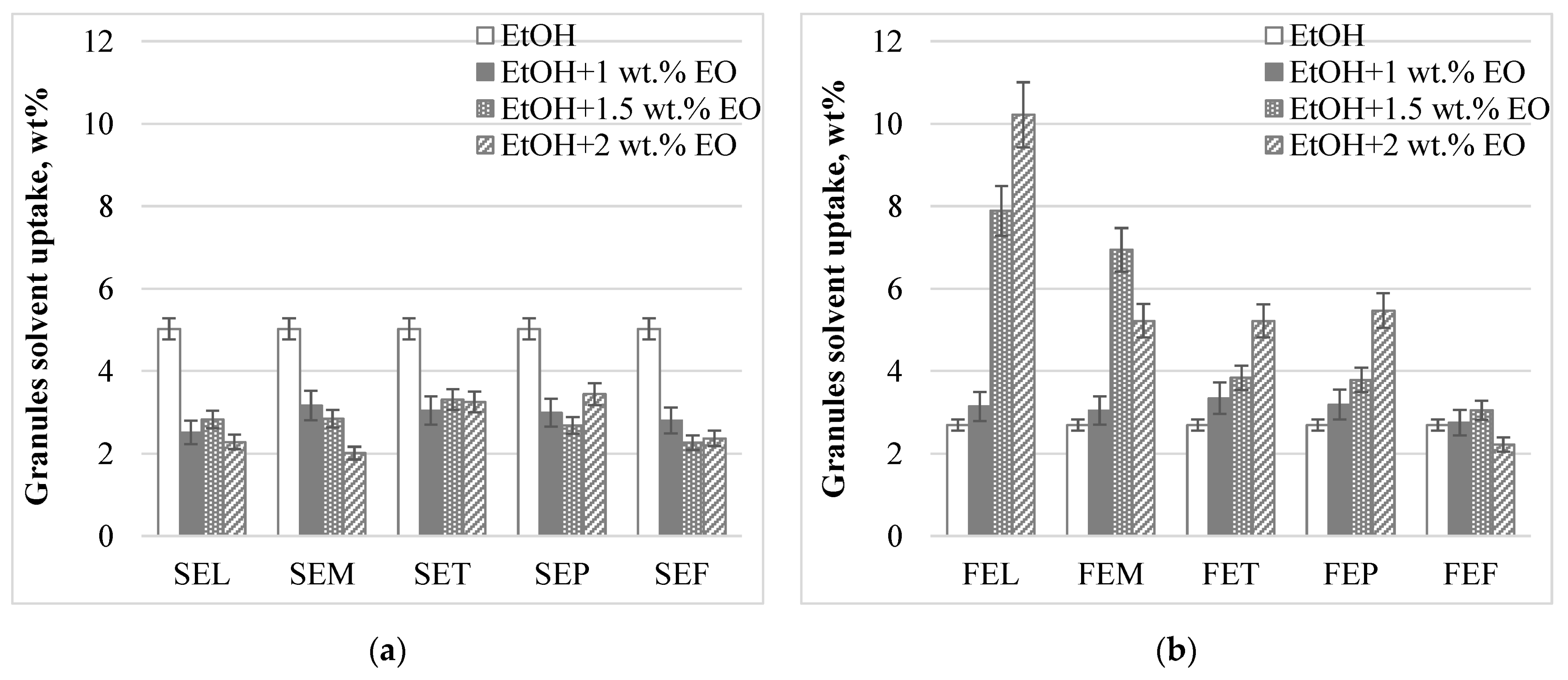
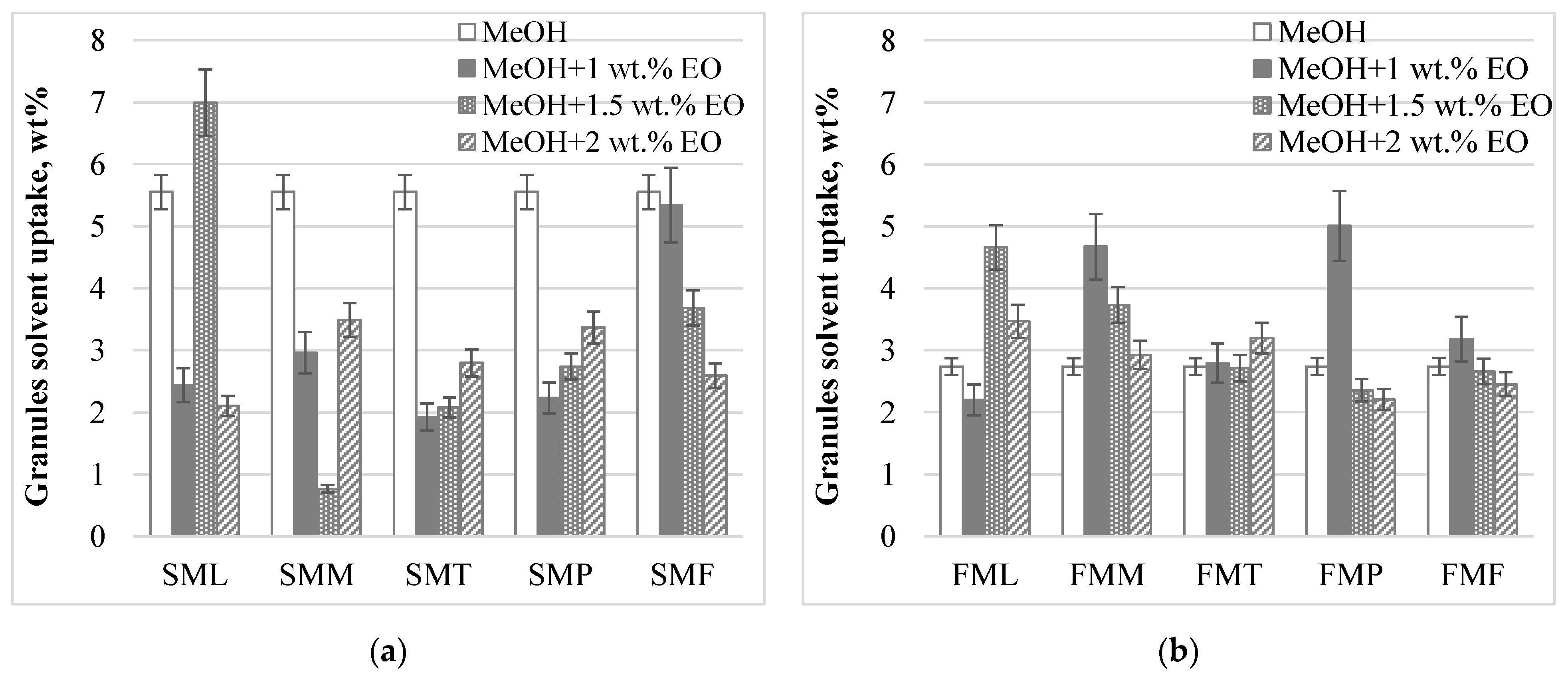
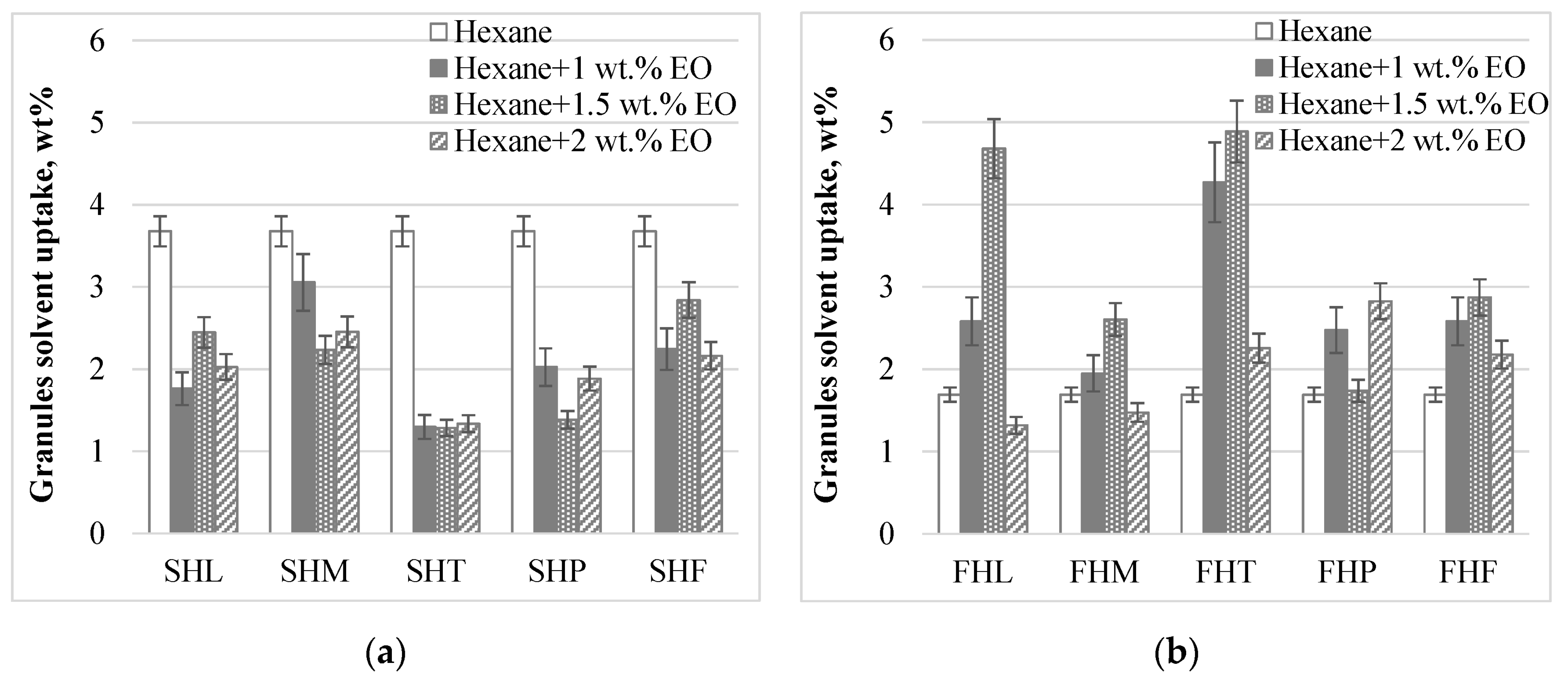
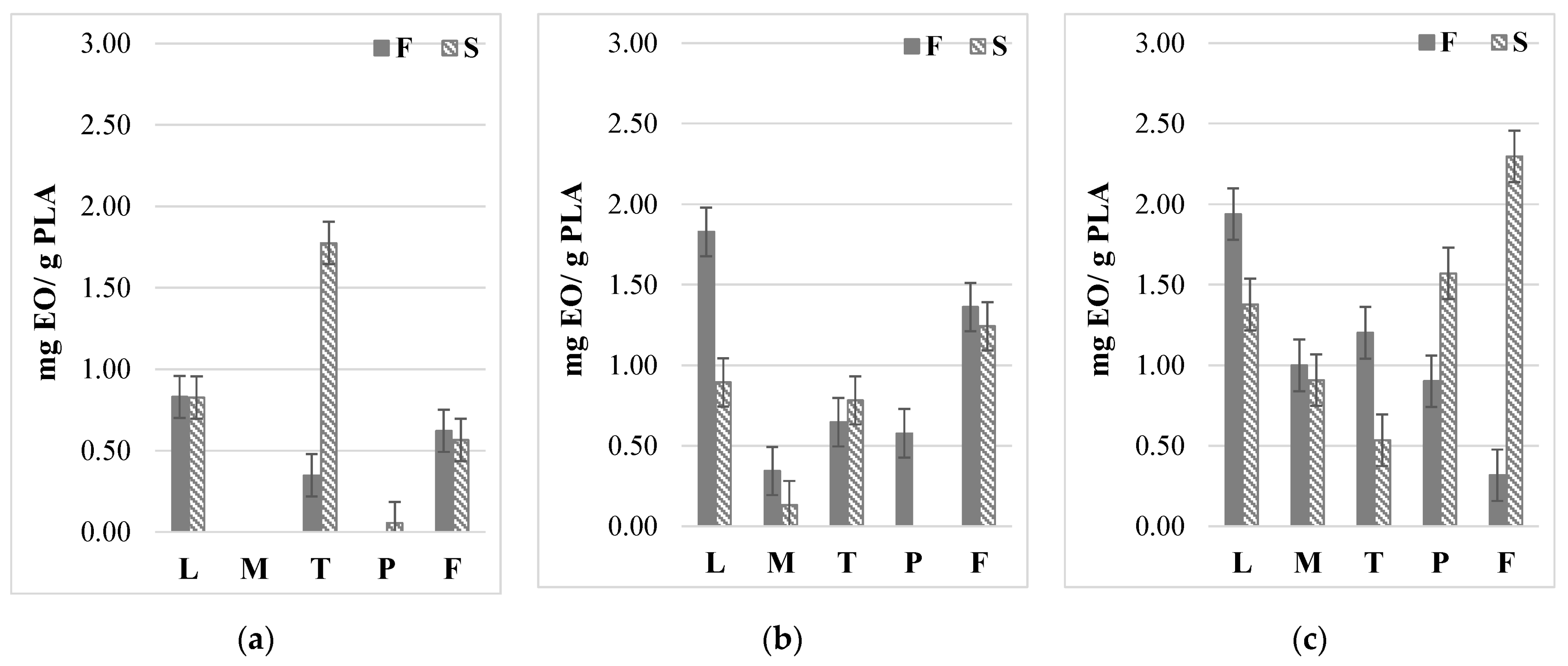
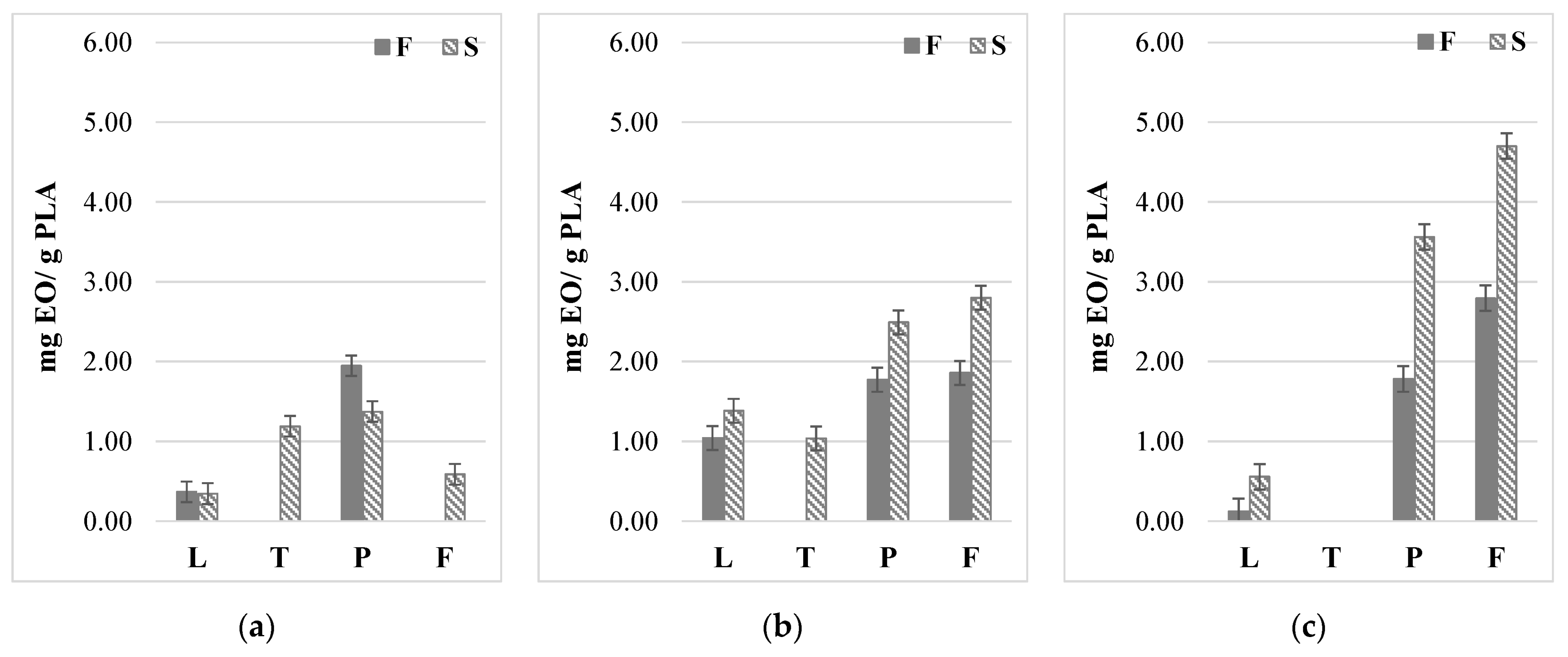
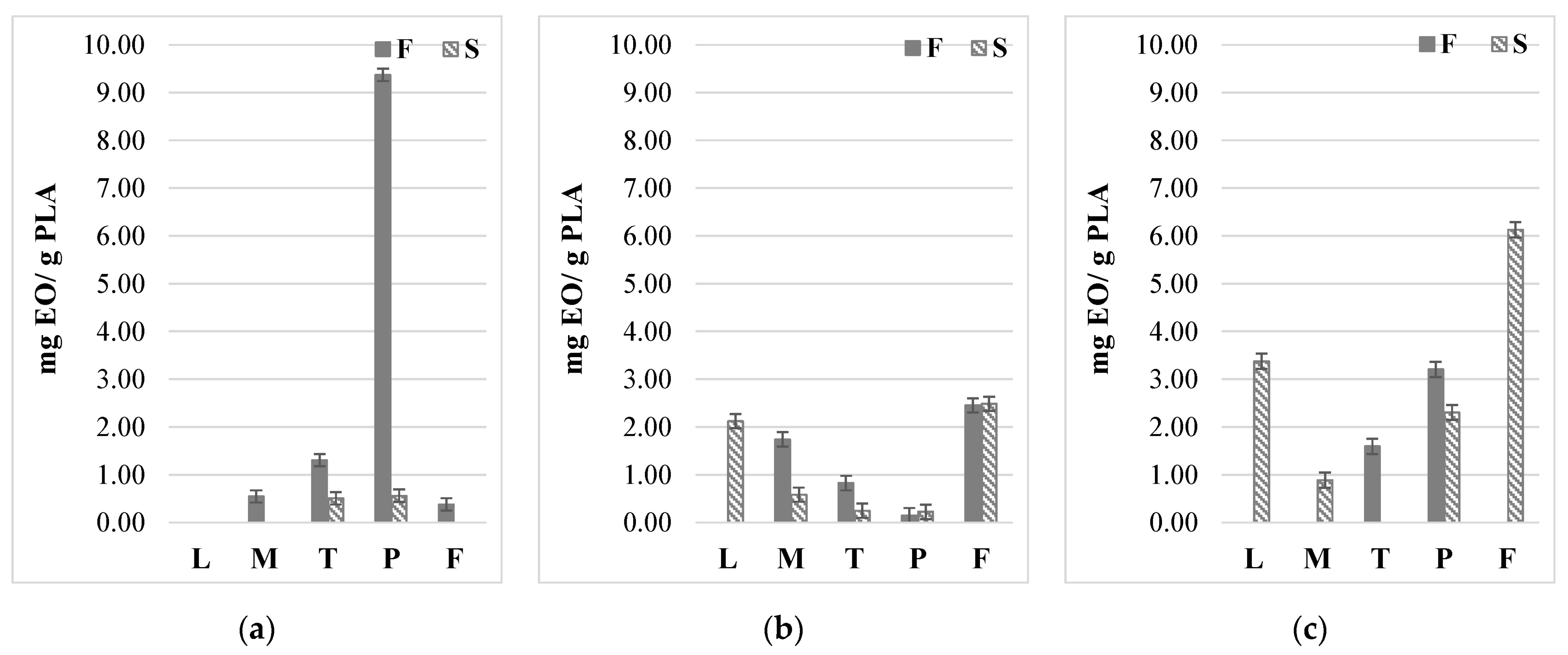

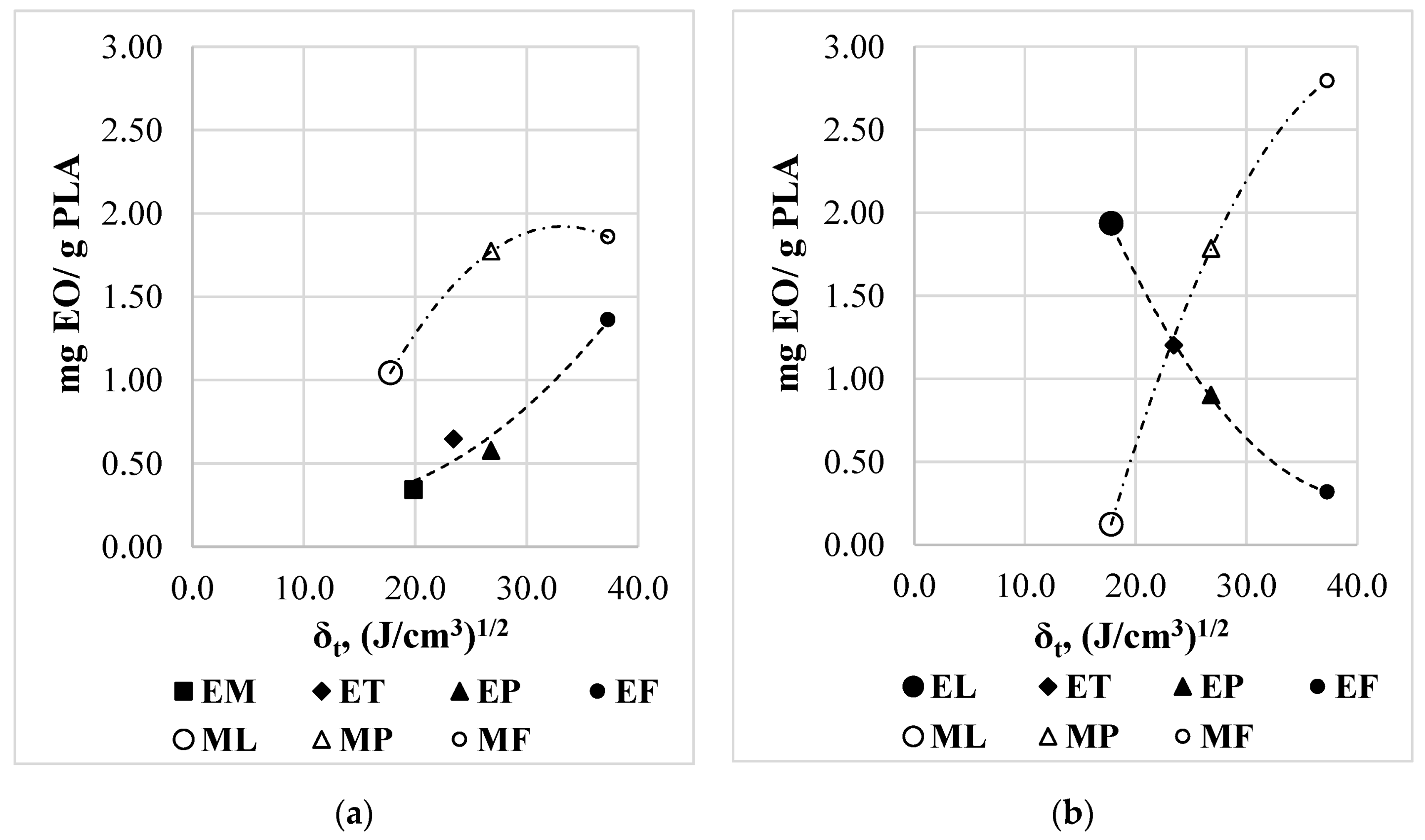
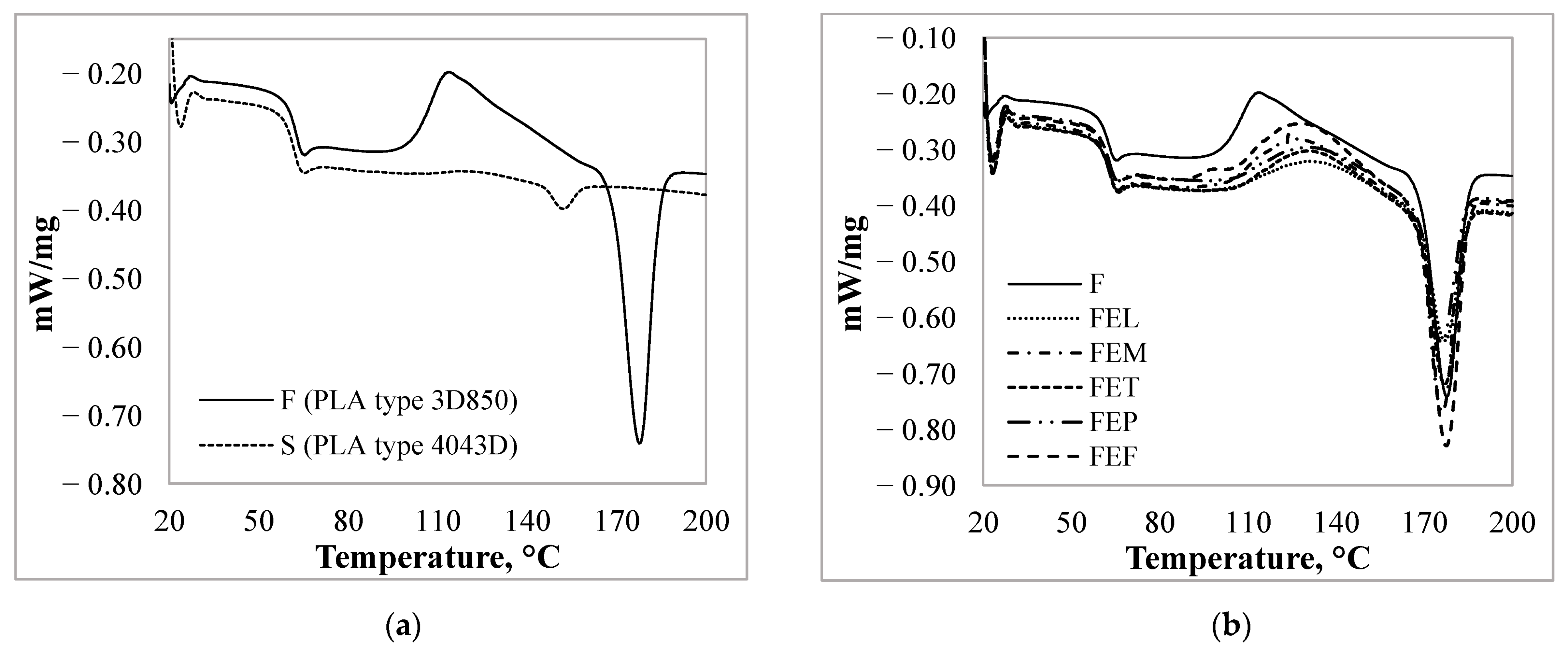
| Granules | Solvents | Essential Oils | Solution Concentration | ||||
|---|---|---|---|---|---|---|---|
| F | 3D850 PLA | E | Ethanol | L | Lemongrass essential oil | 1 | 1 wt.% |
| S | 4043D PLA | M | Methanol | M | Marjoram essential oil | 1.5 | 1.5 wt.% |
| H | Hexane | T | Thyme essential oil | 2 | 2 wt.% | ||
| P | Peppermint essential oil | ||||||
| F | Fennel essential oil | ||||||
| Material | δd, (J/cm3)1/2 | δp, (J/cm3)1/2 | δh, (J/cm3)1/2 | δt, (J/cm3)1/2 | RED |
|---|---|---|---|---|---|
| PLA | 18.6 | 9.9 | 6.0 | 21.9 | - |
| Lemongrass essential oil | 16.4 | 4.6 | 5.1 | 17.8 | 0.65 |
| Marjoram essential oil | 19.5 | 1.3 | 3.2 | 19.8 | 0.87 |
| Thyme essential oil | 21.3 | 3.2 | 9.2 | 23.8 | 0.89 |
| Peppermint essential oil | 25.8 | 4.6 | 5.8 | 26.8 | 1.43 |
| Fennel essential oil | 24.3 | 3.9 | 28.0 | 37.3 | 2.39 |
| Ethanol | 15.1 | 8.4 | 18.3 | 25.2 | 1.33 |
| Methanol | 14.5 | 11.5 | 21.4 | 28.3 | 1.64 |
| Hexane | 14.6 | 0.0 | 0.0 | 14.6 | 1.31 |
| Sample | Tg, °C | Tcc, °C | Tm, °C | ΔHcc, J/g | ΔHm, J/g | Xc, % |
|---|---|---|---|---|---|---|
| F | 61.5 | 113.9 | 177.6 | 16.28 | 27.91 | 12.4 |
| S | 60.7 | 117.0 | 152.0 | 1.23 | 2.13 | 1.0 |
| FEL | 61.8 | 130.8 | 177.1 | 14.56 | 15.07 | 0.5 |
| FEM | 61.4 | 123.8 | 176.2 | 14.56 | 25.09 | 11.2 |
| FET | 61.6 | 129.8 | 177.0 | 17.35 | 19.68 | 2.5 |
| FEP | 61.5 | 130.1 | 175.8 | 14.91 | 16.31 | 1.5 |
| FEF | 61.9 | 128.6 | 177.6 | 23.61 | 28.95 | 5.7 |
| SEL | 60.0 | - | 151.1 | - | 0.39 | 0.4 |
| SET | 60.3 | 118.4 | 150.8 | 0.78 | 1.14 | 0.4 |
| SEF | 60.4 | 117.3 | 150.5 | 1.36 | 3.50 | 2.3 |
Publisher’s Note: MDPI stays neutral with regard to jurisdictional claims in published maps and institutional affiliations. |
© 2022 by the authors. Licensee MDPI, Basel, Switzerland. This article is an open access article distributed under the terms and conditions of the Creative Commons Attribution (CC BY) license (https://creativecommons.org/licenses/by/4.0/).
Share and Cite
Virág, L.; Bocsi, R.; Pethő, D. Method for the Determination of Solvent Sorption of Polylactic Acid and the Effect of Essential Oils on the Sorption Properties. Crystals 2022, 12, 1525. https://doi.org/10.3390/cryst12111525
Virág L, Bocsi R, Pethő D. Method for the Determination of Solvent Sorption of Polylactic Acid and the Effect of Essential Oils on the Sorption Properties. Crystals. 2022; 12(11):1525. https://doi.org/10.3390/cryst12111525
Chicago/Turabian StyleVirág, Lilla, Róbert Bocsi, and Dóra Pethő. 2022. "Method for the Determination of Solvent Sorption of Polylactic Acid and the Effect of Essential Oils on the Sorption Properties" Crystals 12, no. 11: 1525. https://doi.org/10.3390/cryst12111525
APA StyleVirág, L., Bocsi, R., & Pethő, D. (2022). Method for the Determination of Solvent Sorption of Polylactic Acid and the Effect of Essential Oils on the Sorption Properties. Crystals, 12(11), 1525. https://doi.org/10.3390/cryst12111525






